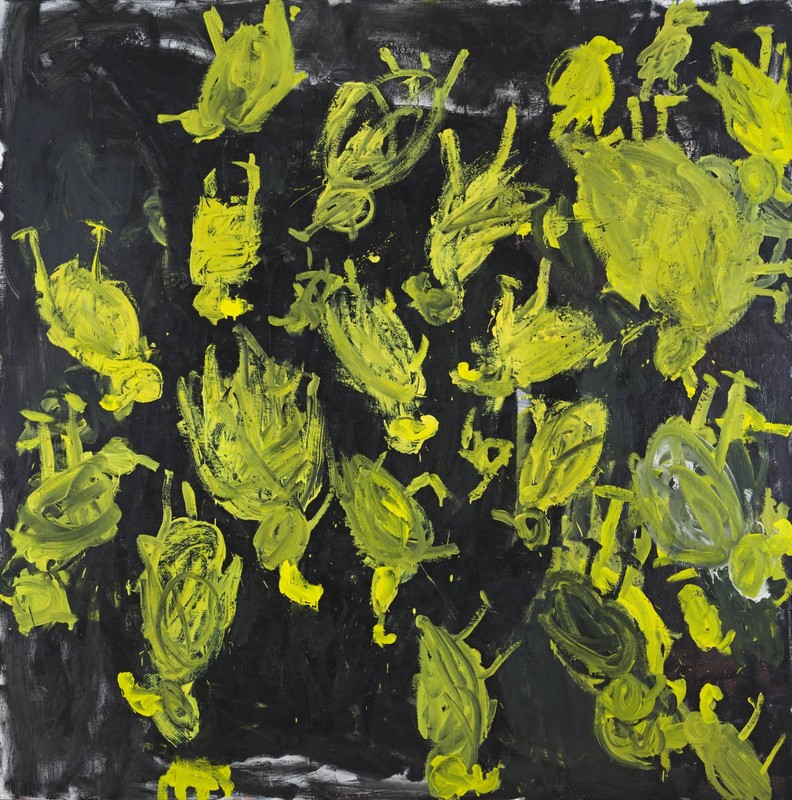Georg Baselitz
27 Apr 2015 - 10 Jan 2016

Georg Baselitz
Where is the Yellow Milkjug, Mrs Bird? 1989
Oil on canvas
support: 2504 x 2505 x 55 mm
ARTIST ROOMS
Acquired jointly with the National Galleries of Scotland through The d'Offay Donation with assistance from the National Heritage Memorial Fund and the Art Fund 2008© Georg Baselitz
Where is the Yellow Milkjug, Mrs Bird? 1989
Oil on canvas
support: 2504 x 2505 x 55 mm
ARTIST ROOMS
Acquired jointly with the National Galleries of Scotland through The d'Offay Donation with assistance from the National Heritage Memorial Fund and the Art Fund 2008© Georg Baselitz
This two-room display presents figurative works in a range of media by the German artist Georg Baselitz.
This display includes works that belong to a collection of international contemporary art jointly owned by Tate and National Galleries of Scotland. It is known as ARTIST ROOMS and focuses on individual rooms devoted to particular artists.
One of the foremost German artists who came to prominence in the 1960s, Baselitz has been concerned with ways to invest renewed significance in the human figure. Born just before the Second World War, he grew up in Communist East Germany and studied in academies on both sides of Berlin before settling in the West. In choosing to engage with a painterly and figurative tradition, he rejected the prevalent trend towards abstraction, but was also careful to avoid an imitative realism tainted by its association with totalitarian propaganda.
In the mid-1960s, Baselitz began to depict what he called ‘new types’ of lone male figures, including series of ‘Rebels’ and ‘Heroes’. Vigorously painted in ways that echo early expressionism, these figures assumed a monumental stature, yet Baselitz wanted to discourage easy judgements about what they represented. In 1969 he took the remarkable step of turning his figures upside-down, unsettling the viewer and allowing the paintings to be seen as almost abstract works.
Throughout his career, Baselitz has absorbed and confronted aspects of German history, capturing uncertainties and anxieties that permeate European culture more widely.
Georg Baselitz was born in 1938 as Hans-Georg Kern. He took the name Baselitz from his birthplace of Grossbaselitz, a village in Saxony, eastern Germany. He lives and works in Basel, Switzerland, at lake Ammersee, Germany, and in Imperia, Italy.
Curated by Matthew Gale
This display includes works that belong to a collection of international contemporary art jointly owned by Tate and National Galleries of Scotland. It is known as ARTIST ROOMS and focuses on individual rooms devoted to particular artists.
One of the foremost German artists who came to prominence in the 1960s, Baselitz has been concerned with ways to invest renewed significance in the human figure. Born just before the Second World War, he grew up in Communist East Germany and studied in academies on both sides of Berlin before settling in the West. In choosing to engage with a painterly and figurative tradition, he rejected the prevalent trend towards abstraction, but was also careful to avoid an imitative realism tainted by its association with totalitarian propaganda.
In the mid-1960s, Baselitz began to depict what he called ‘new types’ of lone male figures, including series of ‘Rebels’ and ‘Heroes’. Vigorously painted in ways that echo early expressionism, these figures assumed a monumental stature, yet Baselitz wanted to discourage easy judgements about what they represented. In 1969 he took the remarkable step of turning his figures upside-down, unsettling the viewer and allowing the paintings to be seen as almost abstract works.
Throughout his career, Baselitz has absorbed and confronted aspects of German history, capturing uncertainties and anxieties that permeate European culture more widely.
Georg Baselitz was born in 1938 as Hans-Georg Kern. He took the name Baselitz from his birthplace of Grossbaselitz, a village in Saxony, eastern Germany. He lives and works in Basel, Switzerland, at lake Ammersee, Germany, and in Imperia, Italy.
Curated by Matthew Gale
